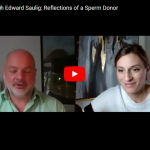Most people’s first introduction to issues like cloning or geneticenhancement will be made through a pop-culture medium like a movie.Recently, the movie industry has even created elaborate faux website companies to advertise upcoming movies. The movie “The Island”, forexample, set up a website called Merrick Biotech (it’s gone now). Merrick advertised its human cloning capabilities much like alegitimate biotech company might.
Recently, I came across another website for a hospital affiliated with Dwayne University Medical College called RYT Hospital. Before reading on please go visit the site.
This may be one of the best fabricated sites that I’ve come across. For most of you, I imagine, the sight of a pregnant man probably was the first indication that all was not as it seemed. Honestly, for a split second, I thought I wasn’t being as diligent about following Reproductive Technology news as I ought to be. The site covers some of the most dramatic emerging technologies: Nanotechnology, Genetic Technology, andTransgenics. The transgenic thinking mouse, Clyve, is probably the mostfar-fetched of the ideas proposed (visit firstgenetics.com in the UK if you want a live chat with a monkey).
I guess the point is that technology is growing at such a rapid pace these days that some of this seems less and less far-fetched. If you told me 10 years ago that a successful face-transplant would take place this year or that you could have embryos made-to-order at the “Worlds First Human Embryo Bank,”I would have thought you were nuts! And I suppose there is even more going on behind the closed doors at our university labs. Not that I’m aconspiracist, I just don’t think there’s enough black ink to keep up with all that is going on.
RYT Hospital is not an advertisement for an upcoming movie. It is an art project in process by web artist Virgil Wong. I read recently that he wants to include a project on the RYT site for “head transplants”- he even links to an old relatedBBC news article. If you browse the RYT site you’ll notice under thePatient Care section that as some of the research projects get headlines they get linked. I imagine Virgil thinks that with time his art may have a life of its own.
Our challenge then is to be diligent. In a society increasingly infatuated with the promises that science will cure our every malady right down to the one sin our genetic makeup, we need to be diligent to see things clearly for what they are. We must weed out the hype and embrace a biotechnology that does not endanger the vulnerable among us — the very young, thepoor, the desperate, and the old.
Paul van der Bijl is Director of New Media at the Center for Bioethics and Culture Network
Author Profile
Latest entries
 Sperm DonationMarch 15, 2022Venus Rising with Edward Saulig: Reflections of a Sperm Donor
Sperm DonationMarch 15, 2022Venus Rising with Edward Saulig: Reflections of a Sperm Donor BioethicsMarch 13, 2022Dr. C. Ben Mitchell: 2022 Ramsey Award Winner
BioethicsMarch 13, 2022Dr. C. Ben Mitchell: 2022 Ramsey Award Winner #BigFertilityMarch 10, 2022Documentary Explores One Woman’s Journey through Egg Donation
#BigFertilityMarch 10, 2022Documentary Explores One Woman’s Journey through Egg Donation BioethicsMarch 9, 2022Questioning the “Science” of the Gender Industry
BioethicsMarch 9, 2022Questioning the “Science” of the Gender Industry

